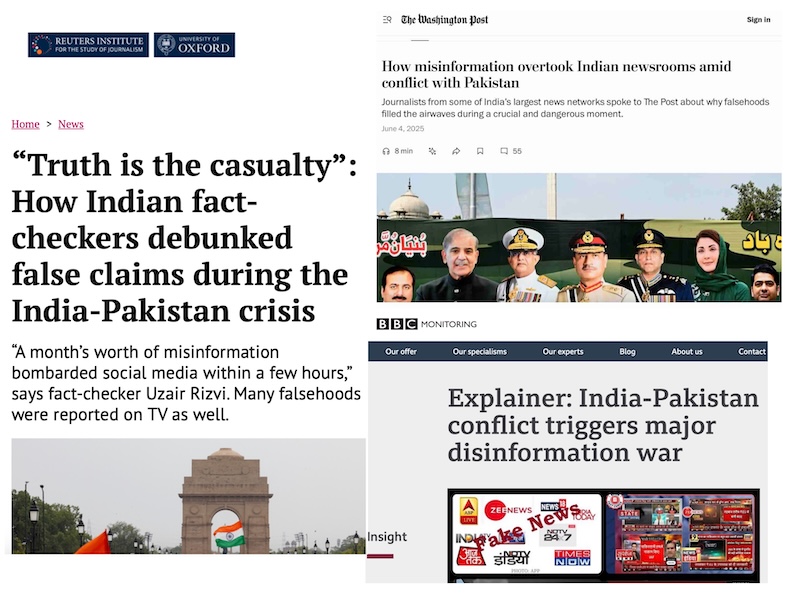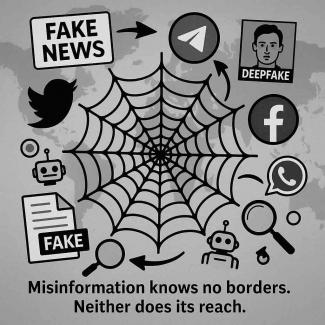Missiles, Misinformation, and Minds: Why India Must Build Information Warfare Infrastructure
The May 2025 India-Pakistan conflict offered a sobering demonstration of how modern wars are no longer confined to physical battlefields alone. Alongside precision strikes and conventional military operations, both countries engaged in a fierce struggle for control over public perception, media narratives, and psychological advantage. The widespread use of misinformation and disinformation across platforms such as X (formerly Twitter), Telegram, Facebook, WhatsApp, and YouTube transformed the conflict into a full-spectrum hybrid war. For India, this underscores an urgent strategic imperative: the need to systematically develop a robust information warfare infrastructure, including the capacity to conduct offensive, defensive, and counter-misinformation operations.
A key case in point was the rumours of an Indian Navy attack on Karachi port on May 9, where Indian precision strikes allegedly targeted military-use infrastructure linked to terrorist supply chains. In response, Pakistani-linked social media networks unleashed an intense disinformation campaign, falsely portraying the attack as a massacre of civilians. Manipulated images from Syria or Gaza, even the Russo-Ukrainian war theatres, were recycled to fabricate claims of war crimes under hashtags such as ##KarachiPortAttack and #indiaattackpakistan, amplified by bot networks and sympathetic influencers across the Subcontinent and diaspora communities. Indian government agencies and civil society fact-checkers were caught reacting belatedly, trying to debunk viral content after it had already shaped international perceptions.
This pattern of disinformation was widespread, contributing to the four-day conflict in May 2025 and its aftermath. The Pahalgam terror attack, where Islamist militants targeted civilians, was spun by Pakistani and Islamist digital networks as an act of "indigenous resistance." At the same time, Indian responses struggled to maintain narrative coherence. Simultaneously, Pakistan-based social media accounts circulated old and unrelated videos to propagate false claims. India's Press Information Bureau (PIB) debunked numerous # IndiaAttackPakistan,
a farm fire misrepresented as a drone strike in Jalandhar, footage of a Beirut blast falsely portrayed as an attack in India, and fabricated reports of a Pakistani missile hitting an Indian S-400 system. Further adding to the information chaos were AI-generated deepfake videos of Indian and Pakistani leaders making inflammatory statements, spoofed ceasefire announcements, recycled IAF helicopter crash footage, and rumours of a suicide attack in Rajouri, ATM shutdowns, and airport entry bans. Collectively, these efforts aimed to sow confusion, distrust, and panic, particularly among border populations, highlighting the aggressive information warfare tactics employed in the conflict.
However, none of this is novel. Misinformation and disinformation are integral tools of modern warfare, just as missiles and predator drones are. From the Cold War era's "active measures" deployed by Soviet intelligence to today's AI-enabled influence operations by both state and non-state actors, information warfare has become institutionalized as a central pillar of strategic competition. To treat it as a surprising or scandalous development, as some media narratives tend to do, is to miss the point entirely. In conflicts where "winning hearts and minds" is as vital as achieving battlefield success, mastery over information ecosystems is indispensable.
Exposing the Asymmetry in the Information War

In the aftermath of the May 2025 conflict, various international media outlets and analysts sought to document the role of misinformation during the crisis. Among these, reports by Karishma Mehrotra in the Washington Post (June 04), Waseem Mushtaq for BBC Monitoring (May 14) and Raksha Kumar for the Reuters Institute (May 29) have received notable attention. These articles collectively highlight how rapidly false narratives spread across digital platforms and how both state and non-state actors exploited the information domain. However, a closer examination of these reports reveals certain analytical gaps and biases that warrant critical reflection, particularly concerning the asymmetric nature of the information warfare waged by Pakistani-linked networks.
While these reports provide valuable documentation of the disinformation environment surrounding the May 2025 India-Pakistan conflict, they exhibit a notable inherent bias in framing the Indian information ecosystem as disproportionately culpable, while largely underplaying the deliberate and systematic information warfare tactics employed by Pakistan-based networks. Kumar's piece positions Indian fact-checkers as reactive and insufficiently transparent but fails to critically assess the state-sponsored orchestration of Pakistani propaganda, which was far more coordinated and aimed at manipulating international narratives. Similarly, Mehrotra's article focuses extensively on the lapses and sensationalism within Indian newsrooms while giving only cursory treatment to Pakistan's aggressive use of bot networks, recycled content, and AI-generated disinformation. Lastly, Mushtaq's BBC Monitoring explainer, though appearing neutral, subtly reinforces an equivalence between Indian and Pakistani disinformation efforts without adequately contextualizing Pakistan's history of state-driven psychological operations and cross-border information warfare. Taken together, these reports risk creating a false balance that obscures the asymmetric nature of the information war, inadvertently lending credence to narratives that undermine India's legitimate security and diplomatic concerns in the conflict.
India currently lacks a coordinated and institutionalized information warfare apparatus comparable to those maintained by many major powers. Ad hoc responses, primarily driven by individual ministries, security agencies, or well-meaning volunteer networks, are no substitute for a dedicated national information warfare command or an inter-agency task force with clear mandates, resources, and doctrine. Such a capability should be multi-tiered:
-
Offensive information operations to proactively shape narratives globally, including the use of calibrated misinformation when strategically necessary.
-
Defensive and counter-misinformation capacities to identify, attribute, and neutralize adversarial propaganda in real-time.
-
Civil-military information coordination to maintain domestic morale and international legitimacy.
-
AI-driven media monitoring and attribution tools to track emerging deepfake and bot-driven campaigns.
-
Strategic partnerships with private sector platforms, fact-checking organizations, and allied intelligence partners for rapid response.
Without such a structured approach, India risks ceding the cognitive dimension of warfare to adversaries like Pakistan or China in the immediate neighbourhood, who are already adept at manipulating it. The lessons of May 2025 should serve as a wake-up call. As the lines between war and peace, state and non-state actors, and physical and digital realms continue to blur, information dominance will increasingly determine strategic outcomes. However, the ongoing 'international delegations' campaign to expose Pakistan's proxy-war strategy is a step in the right direction.
India has a window of opportunity to invest in and institutionalize this domain before the next war erupts. In doing so, it must also ensure that such capabilities are employed responsibly, in line with democratic values and international norms, to maintain both strategic efficacy and moral legitimacy. In the wars of the future, victory will belong not only to those with superior firepower but to those who can most effectively command the battlespace of the mind.
Notes
- Economic Times. (2025, June 1). Modern warfare is no longer linear, but India's wars are now networked, deceptive and home-grown: CDS Gen Anil Chauhan.
- FirstPost. (2025, May 9). India counters Pakistan's fake claims on social media: Operation Sindoor [YouTube]
- Kumar, R. (2025, May 29). Truth is the casualty: How Indian fact-checkers debunked false claims during India-Pakistan crisis. Reuters Institute.
- Mehrotra, K. (2025, June 4). How misinformation overtook Indian newsrooms amid conflict with Pakistan.The Washington Post.
- Mushtaq, W. (2025, May 14). Explainer: India-Pakistan conflict triggers major disinformation war.BBC Monitoring.
- Rid, T. (2020). Active measures: The secret history of disinformation and political warfare. Farrar, Straus and Giroux.
- Stengel, R. (2019). Information wars: How we lost the global battle against disinformation. Grove Atlantic.
